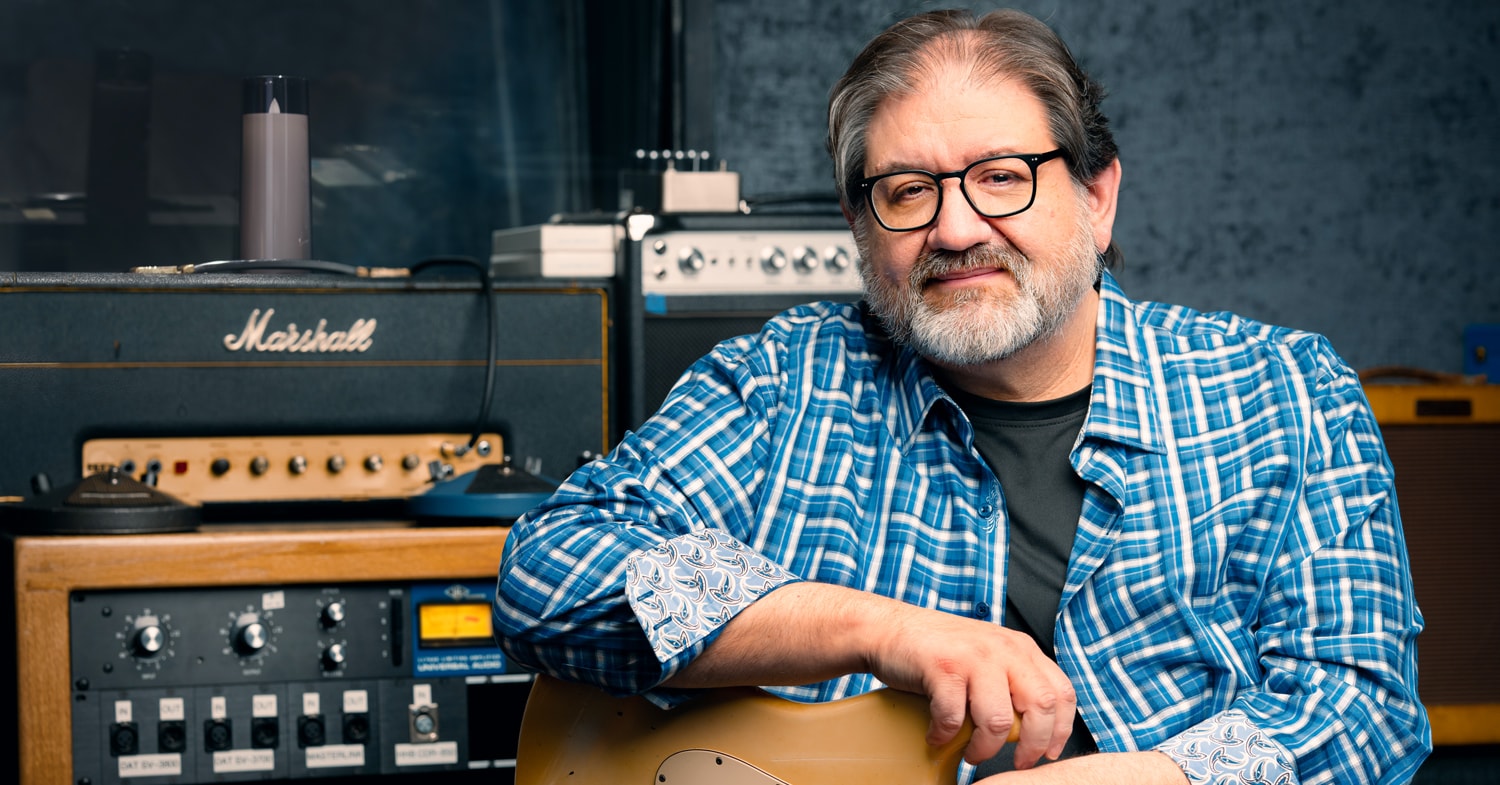Here’s an elevator pitch for your next obsession on Netflix: A celebrated maker of legendary recording gear decides to add guitar pedals to its portfolio and seeks a sonic mastermind to create the hippest and most accurate digital amp models and vintage effects emulations ever heard. Happily, that script has been written, and it’s not a fantasy. Universal Audio—which under its original founder Bill Putnam Sr. [1920-1989] designed studio processors that changed and enhanced the art of recording—sought out industry veteran, renowned tone geek and multifaceted guitarist James Santiago to do just that.
Unfortunately, there was one critical glitch. Santiago was burnt out on DSP projects.
But UA CEO Bill Putnam Jr. persevered—a quest that included hanging out with Santiago to play guitar, discuss some crazy audio experiments and advance the notion that Universal Audio really did want a resident tone chaser for the ultimate guitar sounds.
“That was the spark,” remembers Santiago. “Bill is an extremely technical guy, but he’s also a guitar-playing Deadhead. When he said, ‘We’re not messing around—just go nuts,’ and offered me a team of DSP guys from Stanford to go to town, how can you say ‘no’ to that?”
He didn’t. Now having some big fun as UA’s Senior Product Manager and Sound Designer, Santiago and his team created the OX Amp Top Box reactive load box and recording system and a whole lotta UAFX guitar pedals. In this RIFFS interview, Santiago goes all tone geek on developing accurate models, his passion for sound and his role as UA’s “Grumpy Analog Guy.”
What kicked off such a deep interest in guitar tone and effects?
James Santiago: I was told by my parents—especially my mom—that I gravitated towards the stereo when I was one or two years old. I would listen to music all day long. When I was old enough to pick up a guitar, there was a split-brain thing that happened. I wanted to learn how to play, but I also got wrapped up in trying to find out why I didn’t sound like my heroes. It would be like, “I’m trying as hard as I can to play this riff. Why doesn’t it sound like the thing I’m listening to? What am I missing?”
One of the only places you could learn about stuff—way back in the days of paper—was the articles and interviews in Guitar Player magazine. I don’t know many 12-year-olds who were pacing around their mailbox each month waiting for GP to be delivered. So, I started learning things about chorus pedals, flangers, phasers, compressors and delays. I spent half my time practicing, and the other half trying to decipher how to recreate those chorus, reverb and delay sounds. It became an obsession. And even today, I struggle with the
question, “What are great guitar tones?” It’s a never-ending quest. A daily puzzle that’s so hard to crack—especially as great tone is subjective. A tone that's terrible to my ears is also somebody's Mount Rushmore. But I’m still fascinated with all sounds and effects. I want to learn everybody's tricks.
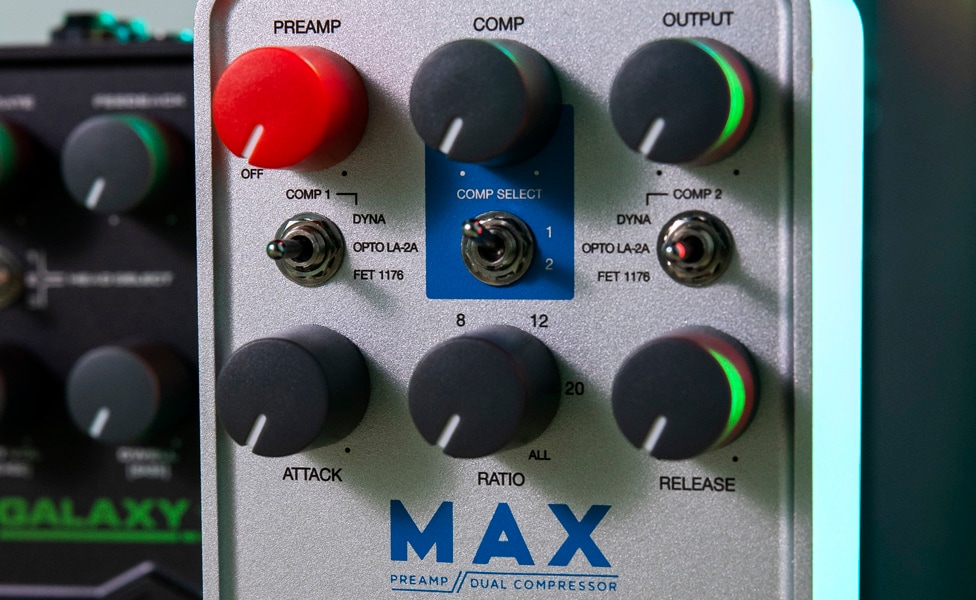
But going from deciphering to building things is a bit of a leap. I wanted to learn about tones, as well, but I never imagined I could actually make the stuff. You jumped right in.
Honestly? It was because I was a broke kid. I would borrow stuff and do things like buy a used Echoplex for $50 and study it. If I needed to fix my guitar or my amp, I had to do it myself, so I’d go to the library and read books about electronics. I hate to say this, but I completely destroyed some of my pedals, because I tore them apart trying to make them something else. But I wanted to unravel something—that was the fun and adventure of it—and I realized there are no rules for creating sound. The rule is to break the rules.
From a design and development standpoint, what drives you crazy about some other modeling devices?
It's funny. There’s this mystique that every piece of vintage gear sounds amazing. That's absolutely wrong. Just because it's old doesn't mean it's great. I hear a lot of vintage Marshalls and Fenders that have been basically destroyed. They were not well taken care of, or they were modified with bad parts and wrong speakers. This is why I always encourage people to listen to multiples of things until they can find one that’s stellar. So, for a lot of sounds that may not be the best, I don’t believe a particular DSP team did bad work. I think, maybe at the starting point, the building blocks weren’t the greatest.
In my case, I’m the only one at fault if I decide, “Well, this is the best-sounding AC30 I've ever heard.” After two years of working on it, you don’t want to go, “Man, that thing is terrible. I picked the wrong AC30.” I mean, I hear a lot of folks who have great intentions saying something like, “We made the best tape delay sound.” Well, it's not. In those situations, I’d like to say, “Let me hear the Echoplex you modeled, because maybe yours wasn't actually working correctly.”
But listen—I own and use a lot of everyone else’s stuff. If you plug into something, whether it’s the best AC30 model or not, if it inspires you to make up a song—or just play guitar—that’s amazing. I’m always more on the positive side of feeling like everything is a useful tool. For example, the Uni-Vibe was developed to emulate a Leslie rotating speaker system. It kind of missed the mark, but it sounded so weird and unique that it became its own category. Competition is good for the industry. I support everybody.
Can you share an example of evaluating multiple sound sources?
I was gifted an old Tweed Deluxe by a friend, and I like it. But I still went to a bunch of places to evaluate others—including the vintage room at Guitar Center Hollywood. They pulled out every tweed Deluxe they had, and I spent the day listening to everything. Then, I continued more tests at other places later on. Throughout the listening sessions, I made a hit list—this one sounds great for clean, this one has a killer lead one, this one sounds terrible for clean and so on. I found out they all have about 80 percent of the same stuff, so it's finding that last 20 percent in an amp, or taking the characteristics of the three or four greatest Deluxe amps I heard to get to that 20 percent.
What does that 20-percent variance typically come down to?
A lot of times, it’s the 20-percent drift that's common in parts. But then you realize that one of the amps never got played. It was in a closet. Another went on the road for 30 years with a guy who played bars. The funny thing is the tweed Deluxe I left with from Guitar Center was the one that looked like hot garbage, but it sounded amazing. It was just played in. Maybe that thing got hot every night and drifted even more, because heat is not good for electronics. But that amp drifted somewhere even better.
Given the varying conditions and different sounds of vintage gear, how do you choose the optimum specimen to model?
It’s a struggle. You ask yourself, “Are we trying to make a model of an amp that left the showroom from a Fender dealer in 1956, or are we attempting to emulate the amp that Neil Young has completely murdered every single night for 40 years? I typically have worse luck with gear that looks near perfect. I like amps with some playing time and a bit of mojo in them.
What’s your criteria for determining whether a particular sound is ready for primetime?
There's one technique I use that defines whether a sound passes or not—I purposely learn the greatest licks and riffs associated with a particular amp. So, if I'm working on a Marshall, my brain is full of every single great Marshall riff under the sun. I play the parts for five or six bars, and I make sure the model not only sounds right, but feels right. After all, if you’re Pete Townshend playing a big A chord, you want the amp to do a certain thing. So, I’ll play that chord over and over: “Do I feel that squish? Do I feel it blooming?” I actually have to let science go a little bit and just plug in and play. I can’t always trust the software tools, I have to be a player to make an evaluation about a specific amp sound. There aren’t a lot of product designers who can accurately play multiple styles, and the playing part saves my butt.
That’s interesting. What was an occasion when playing eclipsed science?
When the Marshall model was sounding pretty close, my gut was telling me something wasn’t right. When I played it, I could feel it fighting me. I told the guy who was working on the code, and he called me an hour later and said, “I don’t know how you discovered it, but the power section was biased incorrectly. It was choking.” Well, it was literally the same thing you would tell a tech if your amp felt stiff, and they’d answer you, “Oh, it’s biased a little cold.” Everything was showing as sonically correct with the Marshall when we checked the tools. Did it feel right? No.
What’s the usual workflow with the team?
We wouldn't be able to do a thing if it wasn't for our DSP engineers. The main person is Dr. David Berners, who is a brilliant musician and genius code guy. He heads up the team—with most of them coming through Stanford University, like Ross Dunkel and Abe Ellison, plus Marco Lo Monaco. I know enough to be dangerous, but I let the experts handle the DSP. All I really want to do is be the grumpy old analog guy.
For example, someone watching the deadlines might say, “We’ve got to stop.” And I’m like, “No—it could be better.” You’re both doing it for the overall good of something, and yet I’m this guy with a big mouth saying it’s not done. But I love those guys. Even when we're fighting, we're fighting to make something better. And sure, it can be brutal at times. You need a tough skin. You need to be with people you trust. Otherwise, you can just sound like the crazy person who's never satisfied.
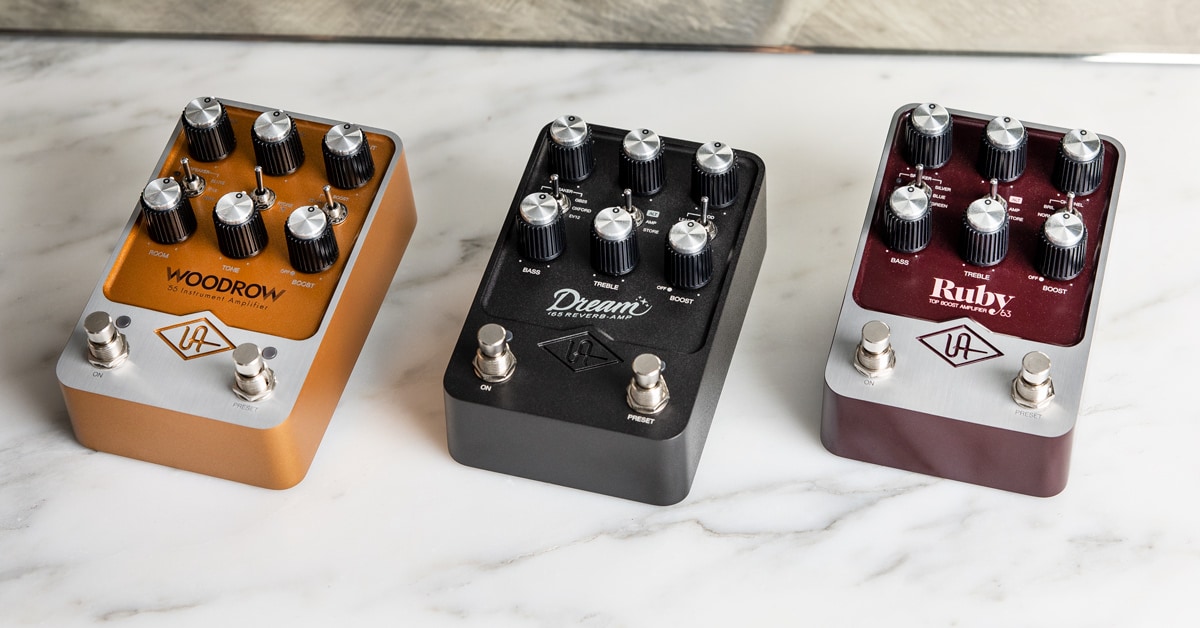
On that note, I'm so grateful to designers such as yourself who put so much into getting the sounds as exact as possible. There’s a historical benefit, because at some point, vintage gear may wallow in museums, rot in landfills or get locked away in collector’s vaults. But what about casual users who have never played any of these vintage amps and effects? Do they know or care about what your team must do to achieve extreme accuracy, or are they fine with tones that sound pretty close to AC/DC, Van Halen or whatever their favorite players might be?
We could probably do things ten times faster if it just had to sound “close enough.” There are tools these days that let you model an amp with artificial intelligence, and those probably sound pretty darn close. But I'm not making these painful strides for a casual user. My goal is more like, “If I could go back in time and give the UAFX Lion ’68 Super Lead Amp pedal to Jimi Hendrix, could he do his job on it?” If I gave the Ruby ’63 Top Boost Amplifier pedal to Brian May could he do a Queen gig with it? Would he be satisfied? The benchmarks in my brain are really high, and they never get completely fulfilled, because we want the tone to be exact.
But you’re right. Most people have never played vintage amps, and many won’t care if a vintage amp model is really accurate. For example, a Line 6 POD will get the job done in many instances, but it will never replace a real Vox AC30, Fender Deluxe, Fender Bassman, or plexi Marshall. However, the industry tends to repeat that “good enough” process. I believe if somebody had made amp models that felt just like the real amps I have, I would have found a different job. I don't want to repeat someone else's work. So, I was all in when Bill Putnam Jr. and his team said to me, “Would you be interested in coming over here and really doing it right? Do everything to make the best amp models ever?” Because I know if someone sticks with the guitar, at some point they are going to know the difference between a great amp model and an okay one. So, all I want to hear is a player saying, “This sounds and feels like a Marshall.”
Is there a way to educate guitarists who love Jimi Hendrix—and want to chase the Hendrix sound—about what a good or bad amp model might be?
As far as a good model goes, the most obvious point is Jimi had his amp at one setting and used his hands and the guitar’s volume control to do all of the shading. So, if you have an accurate model, it should deliver the best clean, dirty and lead sounds you ever heard simply by moving your volume control—and maybe adding a fuzz pedal. It should be that simple. But there are a lot of other amp models that don't play well with that method, and those would be the ones I’d categorize as less accurate.
The Lion ’68 Super Lead Amp pedal can sound Hendrix-y if you just roll up your volume. If you can get an amp to do the right thing, you shouldn’t need ten other things to push it in the right direction. In fact—here’s a little secret—there wasn’t a whole lot of gear used to make every single one of the greatest tones I've ever torn apart. Queen’s was a guitar, a booster and a Vox AC30 non Top Boost. Jimi's was mostly an amp with a fuzz. Even the Edge's stuff—with his complicated rig—is still an AC30 and one delay for a good chunk of what he does. If you can make the main pieces and the tiny pieces work correctly, then you can go to town.
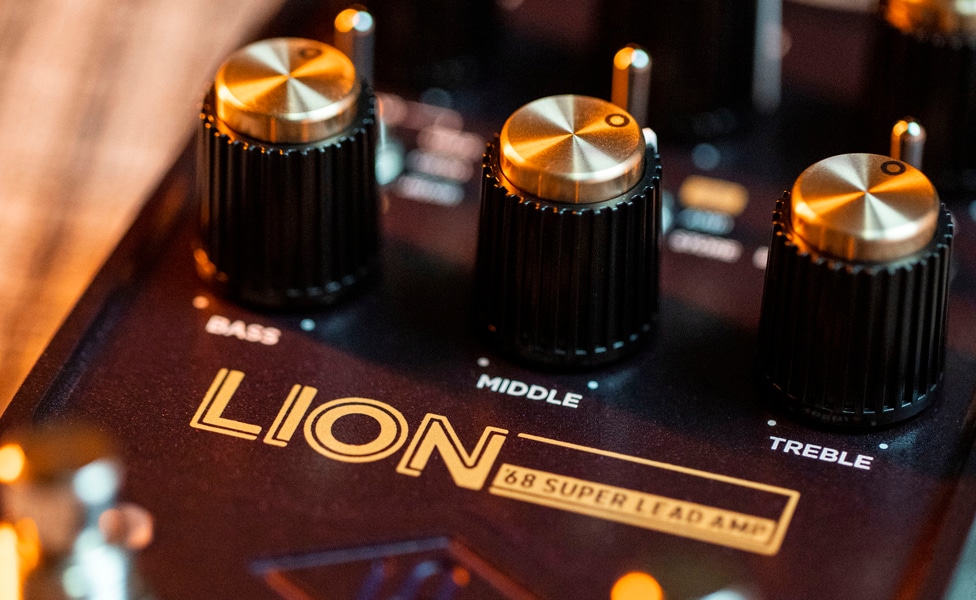
What was it like when you came into Universal Audio to work on what became the OX Reactive Load Box?
I'll tell you immediately how that felt, because it was a very unique situation to be in. When I started at UA, there were low expectations for guitar products. And to be honest, I could not prove OX was going to sell at all. In fact, if you were to do a competitive analysis of load boxes eight years ago, the first thing you’d probably hear is, “What’s a load box?” So, I was already fighting the fact OX had a very narrow market. Expectations were fairly low.
I said every day, “What I'm working on will not keep the lights on in this building. Everybody else’s hard work is giving me the budget to do all of this research with vintage cabinets, mics, speakers and DSP for OX.” What surprised me was the immediate adoption of OX. That was not expected at all.
There’s a lot of great tech in OX besides the reactive load circuitry, such as cabinet emulations and mic-placement simulations. Were there any nagging concerns during its development?
Not with the DSP. I knew I wanted people to plug in and not worry about anything except playing. It was like, “Just plug in and have fun.” But the hardware took a bit of thinking about. The box needed to not look like a hard drive or a Mac sitting on top of your Marshall amp. We didn’t want any digital readouts and or lights flashing on and off. We spent a lot of time envisioning what kind of box should sit on top of an amp— which is why we called it an amp top box. OX has some groundbreaking technology inside of it, but it still looks like a cool box with knobs.
Universal Audio’s portfolio is vast—interfaces, software, plug-ins, channel strips, microphones, pedals and even a DAW. Is there an overarching concept to what makes a UA product a UA product?
In one word, it’s craftsmanship. If I make a mistake, one of the engineers might look at me, and go, “Dude. Craftsmanship.” [Laughs.] And it’s back to the drawing board. We’re all trying to one-up each other in a good way.
For the UAFX pedals, did you recreate everything expressly for that format, or did you transfer UAD-2 plug-ins to the pedal world?
There was a bit of both. But even if we started porting a plug-in into the UAFX platform, we had to listen to everything to ensure it worked for guitar, rather than a studio environment. For example, the Echoplex model we put into the Starlight Echo Station is completely different from the Echoplex used for the UAD plug-ins. I’ll tell you why. For the UAD-2 platform, the company went for the mid-1970s EP-4 version that was a bit more studio friendly with an LED input meter, extra line inputs and bass and treble controls. But that Echoplex is not the version Jimmy Page, Eddie Van Halen and Brian May used. The Starlight had to have an EP-3 [1970-1991] with no tone controls. I said, “I’m redoing this from scratch again.” I mean, this is a guitar pedal, so it needed to be the right Echoplex. We created the Starlight model from one of the EP-3s I’ve been beating up since I was a kid.
Is there some amount of revoicing needed if you move a model from the UAD-2 environment to the UAFX pedals?
Yes. A lot of times, the differences come from gain staging. For example, a classic pedal like the MXR Dyna Comp reacts to a very specific input range from a guitar. So, we spend a lot of time matching settings to a specific amount of input—plus the algorithm needs to think it’s running off of a 9V battery. Any error in the gain stage could mean we might voice the treble frequencies wrong—that kind of thing—which is why we work within a very strict system to ensure consistency. I even use the same guitar cables every time. Due to the effects of capacitance, I couldn’t change a 30-foot cable for a 10-foot cable, because that would cause a high-end roll-off.
We're constantly rechecking things, because gain-staging is a real big issue. There’s a beauty in hitting something just hard enough to do the right thing—especially as UA makes a point of doing everything with what we call “scalability.” If you scale a knob properly, for example, that knob should do exactly the same thing on the model as it does on the read gear. You can only do that if you’ve truly modeled the value of that knob to do the right thing. If you’re faking those things, the knob will sound good on one setting, but if you move it, it falls apart. For example, if I put the volume on 5, and it sounds nothing like the real thing, I don’t care if it sounds perfect at 10. Instead, I’m going, “What did we miss?” It’s painful, because that’s the “go back and fix it” part of the process.
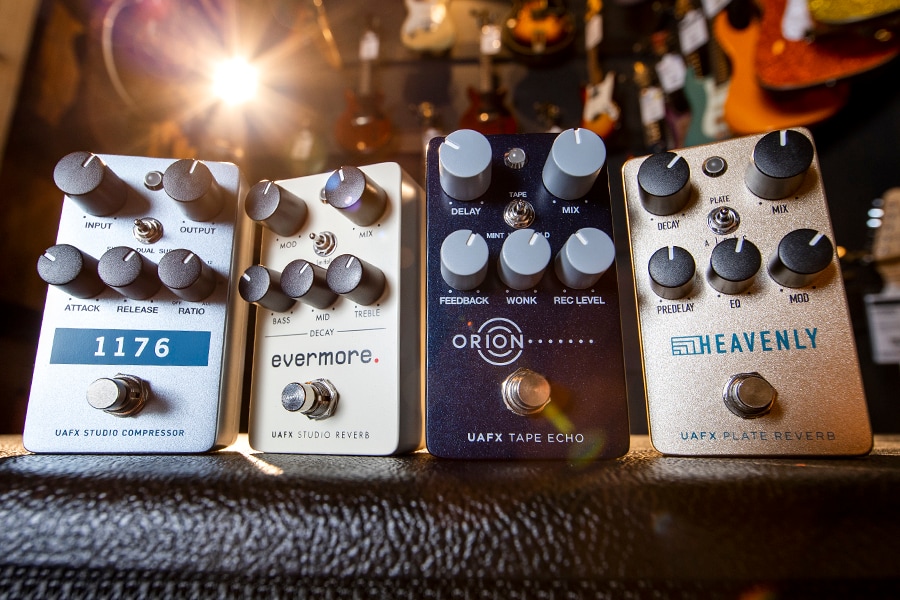
Is grounding an issue when you’re comparing sounds?
It’s funny you asked that, because I find grounding is the most overlooked thing when it comes to mixing a roomful of computers, tube amps and guitar pickups. Clean ground is a nightmare. Let’s go down that rabbit hole for a few seconds. I have one of those Furman IT 20A balanced power conditioners, and I used it for my computers, drives and some of the speaker systems. The day I put my guitar amps on there and isolated them from the other power, my amps sounded terrible. The grounding was not playing ball, because those amps want to see the terrible, crappy output of a 1950s house—like 117 volts. So, the janky part is I bought that giant setup and supply system for my home studio, and I will not use it for my amps. It just does something weird. In fact, if you tell me your amps sound best when the microwave and toaster are on, I believe you. There are even some recording studios that say things like that: “Hey, leave the water cooler on. It’s the sound of the room, man. Do not unplug it.”
What’s it like when you’re working with an icon who wants a digital model to sound just like their real amps? What type of feedback do you get from that level of player?
Those players are sometimes the easiest artists to work with. They’ve owned the real gear—and toured and recorded with it for so long—that they know what to ask us. We also make sure we can replicate their exact signal chain. While working on Ruby, for example, I constantly plugged into my vintage 1964 Vox AC30 and Korg SDD-3000 delay. I learned all of the classic U2 songs and played them for months. I even played early ‘60s and ’70s Stratocasters using the same rare blue-nylon Herdim picks that Edge uses. Those were my benchmarks.
As you’re doing so many emulations of vintage stuff, do you ever consider making something that’s never been heard before? Something radically new?
Yes. Tore Mogensen—who people might know from TC Electronic—is one of the folks on our brain trust, and he and I do Zoom meetings once a week or so to throw around ideas for future products. The discussions have mostly been about amps that may not have been modeled correctly yet, or certain effects that would be cool. But it’s kind of unfair for me to share anything, because it would be years before anyone would see it. But one odd one that’s coming out now is based on the Dolby A noise reduction that was ultimately misused and modded in recording studios to produce an effect that is sometimes called the “vocal trick” or “John Lennon mod.” We found the old Dolby A units that producer Keith Olsen [Fleetwood Mac, Pat Benatar, Journey] had modified to get really breathy vocals and airy acoustic-guitar sounds. It’s really a multiband EQ with dynamics and high-end processing. It’s something we did just for us in our off-hours that ended up turning into a product.
What were some of the non-amp pedals you enjoyed working on?
Probably one of the most fun things for me was doing the Electro-Harmonix Memory Man for our UAFX Starlight and Del-Verb pedals. I love the Memory Man because it’s so nasty-sounding and dirty. You can use it for all of these Radiohead-like effects, because the Memory Man delays can oscillate and do weird stuff. There’s a beauty in the way the modulation and vibrato works in those things. That pedal was a real challenge, because UA had never modeled a Memory Man before, and we had to do the entire circuit all the way down to its op-amp preamp.
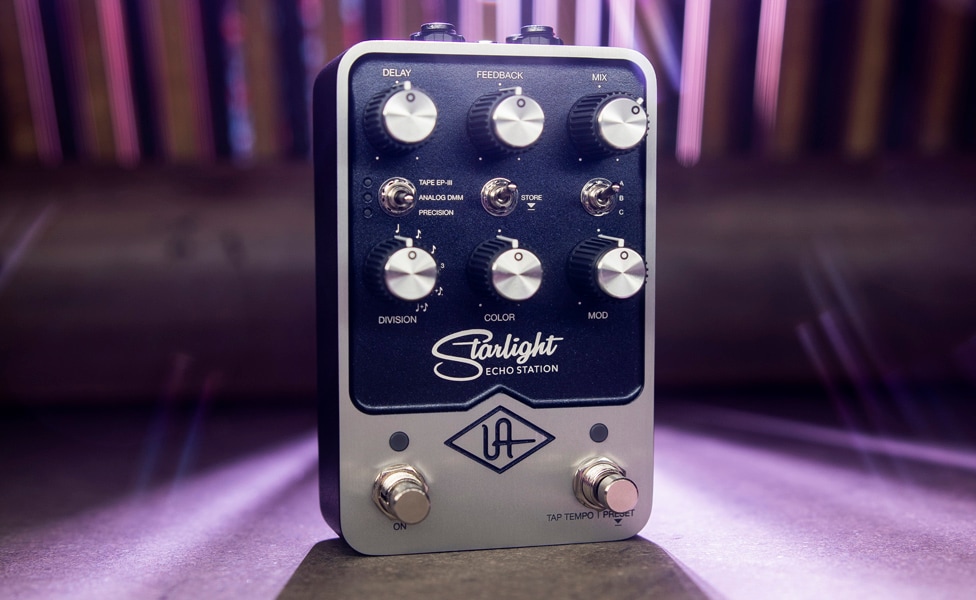
What else?
I love the Echoplex, so it that was fun doing that one for Starlight, Del-Verb and Orion. Here’s something interesting about Echoplex tape-delay units—everyone assumes the vintage models are very dark sounding. Not true. A well-maintained Echoplex with a new tape actually sounds very nice and clean. Rather than limiting you to something dark, we provided users with three different EP-3 options: Mint, Worn and Old. I was able to go back into my closet and pull out my stack of original Echoplex cartridges. I’ve been keeping them since I was a kid, because they, because they stopped making them. And Echoplex units in the 1980s, were mostly used junk. But I kept all the parts to reference for the UAFX project—including the preamps that I loved.
Was there a particular sound that was a big challenge?
It sometimes took a while to do what seemed like simple ones—such as the MXR Phase 90 model that you can download for Astra. I had to do the Phase 90 a couple of ways, because Eddie Van Halen used it a little differently on guitar than Donald Fagen when he put it on his Rhodes. When I dug deeper into the circuits, I realized that the script- and block-logo models really do have different stuff about them. For a minute, I actually wondered if we could get away with just one version. But no. When I hear Fagen’s Rhodes, because he used the block-logo Phase 90, it’s chewier. There’s some regeneration put back into that phase, which makes it a little bit ’70s disco and bell bottoms, as opposed to the script-logo Phase 90, which is light and airy. That’s why “Eruption” sounds the way it does—the phase doesn’t take over.
It sometimes took a while to do what seemed like simple ones—such as the MXR Phase 90 model that you can download for Astra. I had to do the Phase 90 a couple of ways, because Eddie Van Halen used it a little differently on guitar than Donald Fagen when he put it on his Rhodes. When I dug deeper into the circuits, I realized that the script- and block-logo models really do have different stuff about them. For a minute, I actually wondered if we could get away with just one version. But no. When I hear Fagen’s Rhodes, because he used the block-logo Phase 90, it’s chewier. There’s some regeneration put back into that phase, which makes it a little bit ’70s disco and bell bottoms, as opposed to the script-logo Phase 90, which is light and airy. That’s why “Eruption” sounds the way it does—the phase doesn’t take over.
Specifically, what was so difficult about nailing the Phase 90 sound to your standards?
I think it’s just that the Phase 90 can be deceptively simple when you start working with it. Then, you find out the reason it sounds the way it does is because it has such low headroom. It’s actually distorting the whole time. That’s the magic. I hate to say this, but I’m going to say it—when I hear some other people model the Phase 90, they don’t model the clipping circuit. As a result, it’s too polite. It’s too clean. These things had no headroom, so if you played really hard, they would distort. So, if you skip that part of the circuit, you’ll lose the raw aggressiveness, and it will sound too nice.
Let’s talk reverb.
I really like the Lexicon 224 model in the Evermore, Del-Verb and Golden Reverberator. It has the ability to get ambient and spacey to create a sort of music-score vibe. Give me a screwy Memory Man with a long repeat, and some Radiohead-style ambience with a Lexicon 224, and I’m pretty damn happy.
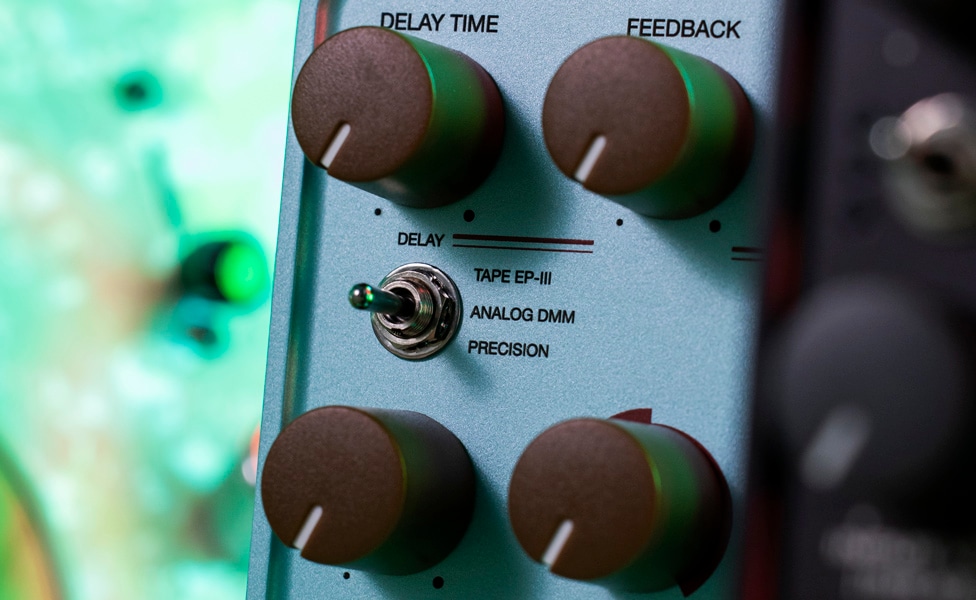
Many of these models were initially programmed to work on SHARC chips, but now it seems UA is adopting the new ARM processors. Is it as easy as simply moving the models from one chip to the other, or is it a more involved process?
The code bases have to be hand-ported for each platform. As much as the coding is just ones and zeros, things can get squirrely. I don’t want to bore anybody with this scientific stuff, but when you change the processor from a SHARC chip to a new platform based on those powerful ARM processors, there can be changes. We may have the core of a model completed, but we can end up redoing our sound design to make sure everything translates to the new platform. We do a lot of listening, and sometimes we have to start from scratch—especially for the guitar team. It’s painful.
You are a details freak, and I mean that in the most complimentary way possible. So, how do you determine when a project is absolutely finished, and you’re okay to start shipping the product?
Well, first there’s the question that’s the same for any writer, painter or creative, which is, “How long are you giving me?” I try to be upfront and honest about the length of the process. I live in a world where our team is waiting to build and ship something, and I’d rather not be the person holding everything up.
But how I determine whether we’ve truly finished something is down to the stupidest thing. I take a few guitars, and I set up an A/B box routed to the real gear and the latest version of the digital model we’re working on. Then, I just start playing while purposely clicking the A/B footswitch, so the sounds bounce back and forth until I don’t know what I’m listening to. The goals is to continuously play my instrument without stopping and saying, “Oh—something’s off.” If I don’t quit playing, I put down my pencil.
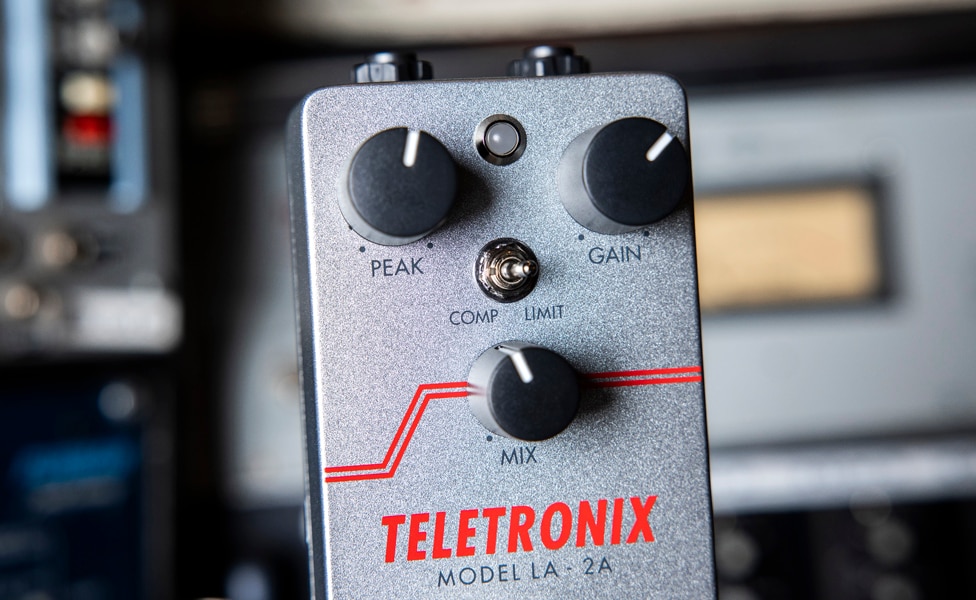
Can you? Really?
Yes [laughs]. If I find I’m sitting deep into it for too long, I know it may be time for me to put down my pencil. It’s much like mixing music. You’ll be working on a song, and there will be someone who says, “Can you bring up the snare drum track one half of a dB?” I’m like, “Come on, dude, a human being can barely hear 0.5dB.” If you find you’re being that person, then you need to give yourself a break, take a vacation and call it a day.
It’s not all that surprising given the task, but it’s still somewhat startling to hear firsthand about how much work is involved in making UAFX pedals.
It is a ton of work, and many of us are still doing it after hours and on weekends. That’s obsession. [Laughs.] But honestly, the joy I get out of this is making sure you don’t have to worry about the sound or how it’s made. It’s my job to worry about that stuff. When you pull up a “Back in Black” preset on the Lion, trust me, we did the homework for you. Just learn how to play those AC/DC riffs, put on a schoolboy outfit, pace around the room and have fun.
For more on UAFX pedals, check out our Universal Audio UAFX Buying Guide.










